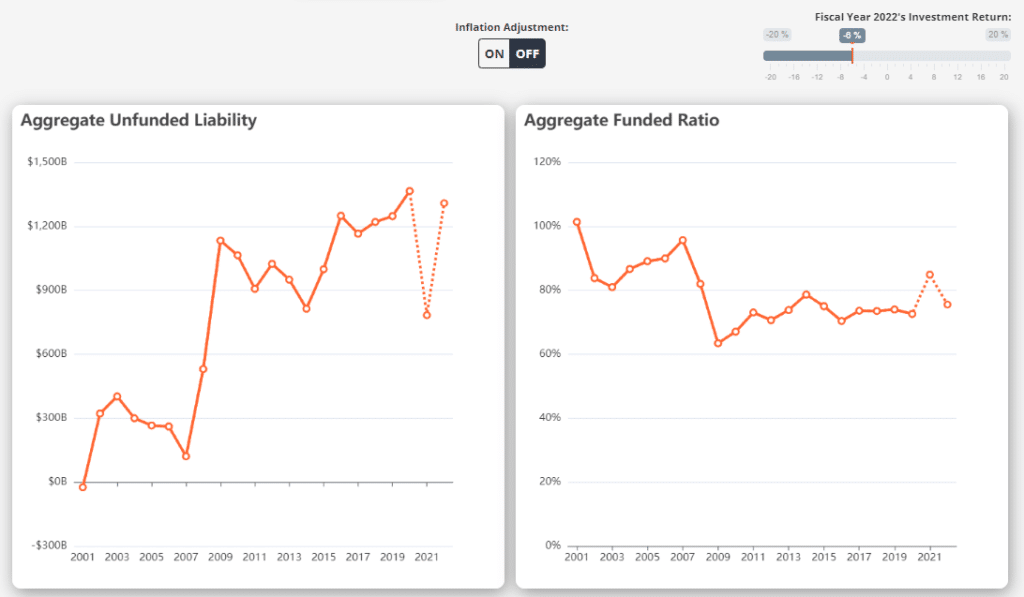This newsletter from the Pension Integrity Project at Reason Foundation highlights articles, research, opinion, and other information related to public pension challenges and reform efforts across the nation. You can find previous editions here. In this issue:
Articles, Research & Spotlights
- Previewing the Impact of 2022 Returns on State Pension Plans
- Arizona and Michigan Dedicated to Closing Unfunded Liabilities
- Texas Teacher Plan Considering Another Return Assumption Adjustment
- Window Closing for Pension Obligation Bonds
News in Brief
Quotable Quotes on Pension Reform
Data Highlight
State Pensions Again Exceed $1 Trillion in Unfunded Liabilities in 2022
Following last year’s record-breaking investment returns, 2022 is shaping up to be a tougher year for public pension plans. A new interactive analysis from the Pension Integrity Project forecasts that poor market results from the 2022 fiscal year are likely to push the aggregate unfunded liabilities of state-run pension plans over $1 trillion, signaling that the vast majority of these plans have not stabilized and still need significant reforms to reverse the course on their funding shortfalls. The 2022 State Pension Forecaster allows users to see how various 2022 investment return rates and scenarios would impact the unfunded liabilities and funded ratios of 118 major state pension plans. For example, if the Teacher Retirement System of Texas (TRS) posts annual returns of -6% for the fiscal year, its unfunded liabilities will jump to $40 billion, and its funded ratio will drop to 83.4%. While exact reports on investment returns are not out yet, the early indicators suggest that the latest fiscal year saw most public pensions miss their assumed rates of return. While a single year of poor results will not make or break a plan’s ability to achieve long-term funding stability, this forecaster shows how most of the ground gained with great returns in 2021 will likely be lost just a year later, further illustrating the environment of high volatility that state pensions face. The forecaster is available here and our webinar demonstrating the tool is here.
Reformed Pensions in Arizona and Michigan Receiving Supplemental Payments
Following major efforts to apply risk- and cost-reducing reforms to their pension plans, lawmakers in both Arizona and Michigan are now directing part of their state budgets to close long-standing unfunded public pension obligations. Arizona first enacted meaningful reforms for state-run public safety pensions in 2016 and has been improving nearly every year since then. Now a set of bipartisan bills will dedicate $1.17 billion to these pension plans, adding to the $1.5 billion paid last year. Similarly, Michigan passed a series of reforms to its public-school employees and state police pension plans over the previous several years and will now see a supplemental $2.5 billion go toward reducing its unfunded pension liabilities. These examples demonstrate the importance of comprehensive pension reform. In both cases, state lawmakers took prudent steps to reduce the growth of pension debt, which—now years later—makes it easier to devote state funds to eliminate the shortfalls in retirement obligations that were generated from the now resolved issues.
Texas’ Teacher Retirement System Needs to Adjust its Investment Return Assumptions
In line with national trends of government-sponsored pension plans, the Teacher Retirement System of Texas (TRS) is considering another reduction to its assumed rate of return. Assumptions on market returns play a significant role in a pension plan’s ability to accurately calculate the annual contributions that are needed to fulfill the retirement benefits promised to its members. To ensure that contributions aren’t falling short, TRS actuaries are suggesting the pension plan reduce its investment return assumption from 7.25% to 7.00%. In response to this potential change, Reason Foundation’s Anil Niraula and Zachary Christensen evaluate the impact that overly optimistic assumptions have had on TRS historically and apply actuarial modeling to project the long-term impact that the assumption reduction will have on the system’s funding.
The Risks of Issuing Pension Obligation Bonds are Rising with Inflation, Interest Rates
Many state and local governments issue pension obligation bonds (POBs) to reduce the long-term costs of holding pension debt, but this maneuver only works if the assets acquired yield more than the bond’s interest plus issuance cost. Essentially, a successful POB relies heavily on timing the market to issue the bonds when interest rates are low. As Reason’s Marc Joffe notes, the window for taking advantage of low rates appears to be closing. The Federal Reserve’s efforts to curtail inflation and deteriorating equity market conditions are putting the prospect of governments being able to reduce long-term costs through pension obligation bonds very much in doubt.
News in Brief
Examining the Purpose and Application of COLAs
A new issue brief from the National Association of State Retirement Administrators (NASRA) reviews the types of inflation protection provided to retirees by government-run pension plans. They find that most plans use some form of cost-of-living adjustment (COLA), although the structure and application of this type of benefit vary greatly from plan to plan. Some governments apply an automatic COLA, meaning the adjustment is predetermined. Others use an ad hoc COLA, which requires legislative approval every year before it is applied. Some systems use performance-based policies to make adjustments only when other returns or funding requirements are met. This brief looks at reforms that have altered COLAs for state-run systems. They find that 17 states have made changes to their COLAs since 2009, eight of which impacted not just new hires, but existing employees as well. The full brief is available here.
Quotable Quotes on Pension Reform
“The funded ratio is back to levels not seen since the initial recovery from the global COVID shutdown”
—Wilshire Managing Director Ned McGuire on the aggregate funding of state pension plans, cited in “State Pension Plan Funding Plunges 11.3 Points in Q2 – Wilshire,” Pensions & Investments, July 8, 2022
“It’s like going to the ATM in Vegas and then going to the roulette wheel and it comes up red and you go back to the ATM…With pensions, you either pay now or pay more later. If you take on a strategy of increasing your risk exposure but you bet the wrong way, you’re really going to get hurt”
– Former City Manager of Pasadena Steve Mermell on using municipal bonds toward unfunded pension liabilities, cited in “Pension Funds Plunge Into Riskier Bets—Just as Market Are Struggling,” The Wall Street Journal, June 26, 2022
Data Highlight
Each month we feature a pension-related chart or infographic of interest generated by our team of Pension Integrity Project analysts. This month, analysts Jordan Campbell and Truong Bui created the interactive 2022 Public Pension Forecaster that allows users to test a variety of potential funding results for all major state-run pension plans, illustrating what the latest year of market experience will mean for plans’ unfunded liabilities and funded ratios.

Contact the Pension Reform Help Desk
Reason Foundation’s Pension Reform Help Desk provides information on Reason’s work on pension reform and resources for those wishing to pursue pension reform in their states, counties, and cities. Feel free to contact the Reason Pension Reform Help Desk by e-mail at pensionhelpdesk@reason.org.
Follow the discussion on pensions and other governmental reforms at Reason Foundation’s website and on Twitter @ReasonPensions. As we continually strive to improve the publication, please feel free to send your questions, comments, and suggestions to zachary.christensen@reason.org.
Stay in Touch with Our Pension Experts
Reason Foundation’s Pension Integrity Project has helped policymakers in states like Arizona, Colorado, Michigan, and Montana implement substantive pension reforms. Our monthly newsletter highlights the latest actuarial analysis and policy insights from our team.

